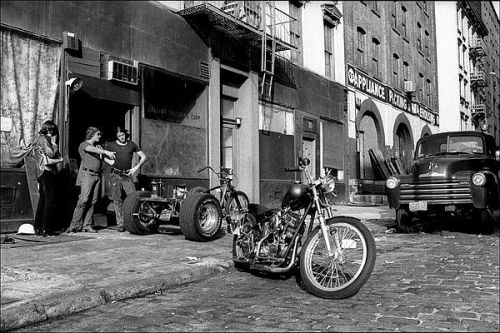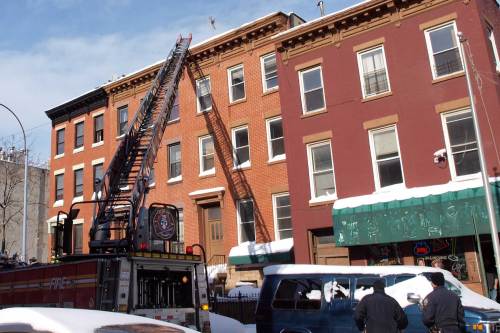 Steve Cannon turned 75 the week before last. His birthday party was held at the Tribes gallery, his home since the 70’s, with readings by Karl Watson, Michael Carter, Shalom Naumen, and the ‘Unbearable’s book release party.
Steve Cannon turned 75 the week before last. His birthday party was held at the Tribes gallery, his home since the 70’s, with readings by Karl Watson, Michael Carter, Shalom Naumen, and the ‘Unbearable’s book release party.
I got there late, after both the readings were over. The food trays picked clean, though half a box of wine remained. Steve was sitting on his living room couch in front of the apartment doorway, the same place I’ve found him almost every time I’ve gone to see him over the last 20 years. Drinking wine, smoking, and hanging out with the dozens of people pressed in around him.On the walls were the striking photographs of the GirlEye show curated by the gallery. Everyone was drunk. It was just like old times.
Steve comes from New Orleans originally, but he’s been in New York since the 70;s. He is a poet, playwright, and novelist, and was a long-time professor at CUNY until he retired in the early 90’s. In the 70’s, he had a bestselling novel: “Groove Jive & Bang Around”, which gave him the money to buy the building he lives in now. He is almost fully blind, and has been so for the last dozen years, the end result of glaucoma. He has people read his books and newspapers and emails to him, but still gets out to shows and readings. He has plenty of help around the studio, and many people drop by. I doubt he’s alone much.
When I first started going down in the early 90’s, the gallery was just starting up and Steve could still see, though he wore dark glasses, even at night. On warm days, he hung out on his stoop, and everyone he knew from in and around the neighborhood would drop by. Some days, you could get a reasonable cross-section of the Lower East Side of the time – young white bohemians like myself, old black poets 
and writers who’d known Steve for decades, local Puerto Ricans, drug addicts. Many of the people around him were stalwarts of the 80’s Lower East Side writing music art drug scene. Some, like the poet John Ferris, had hung out in the political and writing scene in 60’s and 70’s Harlem.
I liked Steve and John and the other guys, and liked the connection to black NY history and art. Most of all, I liked to listen to them talk politics. They really knew their stuff, and in the self-referential, curiously parochial New York of the day, it was refreshing to talk with people who knew what was happening in what was left of the Soviet Union, Iraq, or Africa, unfiltered by the lens of the New York Times or CNN.
I had another connection with Steve: we’d both squatted in London, in roughly the same neighborhood, though 20 years apart – me in the late 80’s, Steve in the 60’s. I’d been in Westbourne Park, then virtually abandoned, Steve in Kilburn, the then Irish neighborhood in the north of the city. “We thought we were broke,” Steve said, “but there was a bunch of motherfuckers across the street – they had nothing at all! We were rich compared to them!”
 By the mid-90’s, the Tribes gallery was becoming something of a local institution. Despite the glaucoma, Steve was involved in the rebirth of the Nuyorican Poet’s Cafe, in the Living Theatre, and Bullet Space. His stoop, and his gallery became a popular hangout for a lot of kids arriving in town from Europe, Japan, across America. Bit by bit, I stopped going down.
By the mid-90’s, the Tribes gallery was becoming something of a local institution. Despite the glaucoma, Steve was involved in the rebirth of the Nuyorican Poet’s Cafe, in the Living Theatre, and Bullet Space. His stoop, and his gallery became a popular hangout for a lot of kids arriving in town from Europe, Japan, across America. Bit by bit, I stopped going down.
But in a Lower East Side I hardly recognize, it’s good to see Steve, and his piece of history, still providing the conduit to the past.















T-Poutine and Early Memories of the Lower East Side
Posted in Comment, New York History, NYC in the 90's, Observations, tagged Lower East Side, Ludlow Street, T-Poutine, They Live! on April 13, 2010| 11 Comments »
We met at T-Poutine, a narrow hole-in-the-wall on Ludlow Street. Forty Canadians, a couple of Americans, there for that curiously popular French-Canadian specialty, poutine. French fries with cheese curds, covered in gravy. T-Poutine is run by an ex-Quebecer, Thierry Pepin, and they serve poutine in all kinds of flavors, from smoked meat to ‘tree-hugger’ (sliced mushrooms). In Montreal you always had poutine plain, so that’s how I had it. And it was the real thing, as close to the Montreal version as you’ll have in New York – or anywhere.
Memories of Montreal Pool Room in the early 90’s at the bottom of St. Laurent, just below rue St. Catherine, the long, long avenue that bisects Montreal east to west, English side to French. An area dominated by strip bars, and tavernes where they played hardcore porn on the overhead TV’s inside and everyone from the bikers (or would be bikers) and their women, to the old men who probably came in every day to the waitresses, totally ignored it. The once-great punk club, Foufounes Electrique, just around the corner, and after hanging out until two or three or four am, you’d drop into the Montreal Pool Room and join the line up of just out of the bar aficianados for poutine, hot dogs, or just the best fries in the city with the best cuisine in North America, hoping it would take off the worst of the hangover the next day. Which of course it didn’t.
Memories too of my first journeys to New York and America in the late 1980’s, riding the night train down the Eastern Seaboard. Drinking in a lounge car full of raucous, mostly blue-collar Americans from Vermont or Massachusetts, knocking back one dollar cans of bud with shots of Jack Daniels, and some big black dude with an afro playing Jimi Hendrix medleys on a farfisa organ in the corner. Arriving with the Bronx dawn spilling out the train window, those magnificent power station chimneys rising up beside the Hudson. Stumbling out into Penn Station with two hours sleep, still drunk.
I hung out on the Lower East Side in those days, drank just up the street. The Lower East Side was still mostly Puerto Rican, the dealers lined Rivington, the bars that cover the area just starting to make inroads on upper Ludlow. I had a friend down on Clinton and I’d stay at his loft space overlooking the Williamsburg Bridge. The doorbell didn’t work so you had to shout up and hope he heard you over the traffic noise from Delancey so he could open the window and throw down the key four stories down to the street, the key insulated with a felt glove so it wouldn’t fall on anyone and maim them. I don’t recall the LES being heavy exactly, but when you stepped outside, you were aware of being somewhere not quite America, with the Spanish on the streets, the stores with the religious icons, the music, the food. And the energy – so much energy and tension in those narrow streets. Going back to Montreal always felt like odd, like a deflation, and it would take me days to find myself again.
After the poutine, we drank vodka supplied by the good folks at the restaurant, then stepped onto a Ludlow I hardly recognized. Some of the old bars still there, Katz’s Deli still there, but I never imagined that the Lower East Side, like (to a much lesser degree), the neighborhood I hung out in up in Montreal, would become a hangout for the affluent. In this case, the very affluent. The same crappy streets, same wine-dark tenement buildings with the iron fire escapes – and a whole lot of bars, restaurants and very fancy cafes, the kind I would never have imagined down here even ten years ago. Even five years ago.
And on a day when the rest of New York was deserted with the holidays and the heat, the LES was packed. It had this strange gloss, like the gloss of a movie set, and I kept thinking of They Live!, John Carpenter’s godawful yet increasingly prescient portrayal of a world run by alien yuppies, because watching these folks, you’d never know there was a recession on, and I had to wonder, as I often do when I’m certain part of Manhattan or Brooklyn: who the fuck are these people?
Read Full Post »